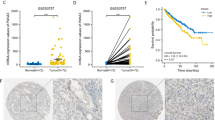Abstract
The aim of our study was to elucidate the role of Rap2B in the development of human suprarenal epithelioma and to investigate the effect of Rap2B on suprarenal epithelioma cells migration and invasion. We use tissue microarray and immunohistochemistry to evaluate Rap2B staining in 75 suprarenal epithelioma tissues and 75 tumor-adjacent normal renal tissues. And the expression of Rap2B protein in human suprarenal epithelioma cells and tissues was detected by western blot simultaneously. The role of Rap2B in suprarenal epithelioma cells migration and invasion was detected by using wound healing assay, cell migration assay, and matrigel invasion assay. After that, we performed western blot analysis and gelatin zymography to detect MMP-2 protein expression and enzyme activity. Our research showed that Rap2B expression was increased in tumor tissues compared with tumor-adjacent normal renal tissues. But no correlation was found between Rap2B expression and clinicopathological parameters. In addition, we found that Rap2B promoted the cell migration and invasion abilities, and Rap2B increased MMP-2 expression and enzyme activity in suprarenal epithelioma cells. Our data indicated that Rap2B expression is significantly increased in human suprarenal epithelioma and Rap2B can promote the cell migration and invasion abilities, which may provide a new target for the treatment of suprarenal epithelioma.





Similar content being viewed by others
References
Siegel R, Naishadham D, Jemal A. Cancer statistics, 2012. CA Cancer J Clin. 2012;62(1):10–29. doi:10.3322/caac.20138.
Mohammed A, Shergill I, Little B. Management of metastatic renal cell carcinoma: current trends. Expert Rev Mol Diagn. 2009;9(1):75–83. doi:10.1586/14737159.9.1.75.
Kausch I, Jiang H, Ewerdwalbesloh N, Doehn C, Kruger S, Sczakiel G, et al. Inhibition of Ki-67 in a renal cell carcinoma severe combined immunodeficiency disease mouse model is associated with induction of apoptosis and tumour growth inhibition. BJU Int. 2005;95(3):416–20. doi:10.1111/j.1464-410X.2005.05312.x.
Janzen NK, Kim HL, Figlin RA, Belldegrun AS. Surveillance after radical or partial nephrectomy for localized renal cell carcinoma and management of recurrent disease. Urol Clin N Am. 2003;30(4):843–52.
Ohmstede CA, Farrell FX, Reep BR, Clemetson KJ, Lapetina EG. RAP2B: a RAS-related GTP-binding protein from platelets. Proc Natl Acad Sci U S A. 1990;87(17):6527–31.
Farrell FX, Ohmstede CA, Reep BR, Lapetina EG. cDNA sequence of a new Ras-related gene (Rap2B) isolated from human platelets with sequence homology to rap2. Nucleic Acids Res. 1990;18(14):4281.
Zhang X, He Y, Lee KH, Dubois W, Li Z, Wu X, et al. Rap2B, a novel p53 target, regulates p53-mediated pro-survival function. Cell Cycle. 2013;12(8):1279–91. doi:10.4161/cc.24364. Georgetown, Tex.
** TG, Satoh T, Liao Y, Song C, Gao X, Kariya K, et al. Role of the CDC25 homology domain of phospholipase C epsilon in amplification of Rap1-dependent signaling. J Biol Chem. 2001;276(32):30301–7. doi:10.1074/jbc.M103530200.
Kelley GG, Reks SE, Ondrako JM, Smrcka AV. Phospholipase C(epsilon): a novel Ras effector. EMBO J. 2001;20(4):743–54. doi:10.1093/emboj/20.4.743.
Kelley GG, Reks SE, Smrcka AV. Hormonal regulation of phospholipase C epsilon through distinct and overlap** pathways involving G12 and Ras family G-proteins. Biochem J. 2004;378(Pt 1):129–39. doi:10.1042/bj20031370.
Song C, Hu CD, Masago M, Kariyai K, Yamawaki-Kataoka Y, Shibatohge M, et al. Regulation of a novel human phospholipase C, PLC epsilon, through membrane targeting by Ras. J Biol Chem. 2001;276(4):2752–7. doi:10.1074/jbc.M008324200.
Song C, Satoh T, Edamatsu H, Wu D, Tadano M, Gao X, et al. Differential roles of Ras and Rap1 in growth factor-dependent activation of phospholipase C epsilon. Oncogene. 2002;21(53):8105–13. doi:10.1038/sj.onc.1206003.
Bourguignon LY, Gilad E, Brightman A, Diedrich F, Singleton P. Hyaluronan-CD44 interaction with leukemia-associated RhoGEF and epidermal growth factor receptor promotes Rho/Ras co-activation, phospholipase C epsilon-Ca2+ signaling, and cytoskeleton modification in head and neck squamous cell carcinoma cells. J Biol Chem. 2006;281(20):14026–40. doi:10.1074/jbc.M507734200.
Bai J, Mei PJ, Liu H, Li C, Li W, Wu YP, et al. BRG1 expression is increased in human glioma and controls glioma cell proliferation, migration and invasion in vitro. J Cancer Res Clin Oncol. 2012;138(6):991–8. doi:10.1007/s00432-012-1172-8.
Hannon GJ. RNA interference. Nature. 2002;418(6894):244–51. doi:10.1038/418244a.
Elbashir SM, Harborth J, Weber K, Tuschl T. Analysis of gene function in somatic mammalian cells using small interfering RNAs. Methods. 2002;26(2):199–213. doi:10.1016/s1046-2023(02)00023-3. San Diego, Calif.
Torti M, Lapetina EG. Structure and function of rap proteins in human platelets. Thromb Haemost. 1994;71(5):533–43.
Rundhaug JE. Matrix metalloproteinases and angiogenesis. J Cell Mol Med. 2005;9(2):267–85.
Deryugina EI, Quigley JP. Matrix metalloproteinases and tumor metastasis. Cancer Metastasis Rev. 2006;25(1):9–34. doi:10.1007/s10555-006-7886-9.
Badiga AV, Chetty C, Kesanakurti D, Are D, Gujrati M, Klopfenstein JD, et al. MMP-2 siRNA inhibits radiation-enhanced invasiveness in glioma cells. PLoS One. 2011;6(6):e20614. doi:10.1371/journal.pone.0020614.
Overall CM, Kleifeld O. Tumour microenvironment—opinion: validating matrix metalloproteinases as drug targets and anti-targets for cancer therapy. Nat Rev Cancer. 2006;6(3):227–39. doi:10.1038/nrc1821.
Jung CH, Kim EM, Park JK, Hwang SG, Moon SK, Kim WJ, et al. Bmal1 suppresses cancer cell invasion by blocking the phosphoinositide 3-kinase-Akt-MMP-2 signaling pathway. Oncol Rep. 2013;29(6):2109–13. doi:10.3892/or.2013.2381.
Lu CY, Lai SC. Induction of matrix metalloproteinase-2 and −9 via Erk1/2-NF-κB pathway in human astroglia infected with Toxoplasma gondii. Acta Trop. 2013;127(1):14–20. doi:10.1016/j.actatropica.2013.03.004.
Bae IH, Park MJ, Yoon SH, Kang SW, Lee SS, Choi KM, et al. Bcl-w promotes gastric cancer cell invasion by inducing matrix metalloproteinase-2 expression via phosphoinositide 3-kinase, Akt, and Sp1. Cancer Res. 2006;66:4991–5.
Acknowledgments
This work was supported by grants from the National Natural Science Foundation of China (NO. 81201637, NO.81071831 and NO. 81272207), Jiehui Di was sponsored by Qing Lan Project of Jiangsu Province.
Conflicts of interest
None
Author information
Authors and Affiliations
Corresponding authors
Additional information
Jie-Hui Di and De-Bao Qu contributed equally to this work.
Rights and permissions
About this article
Cite this article
Di, JH., Qu, DB., Lu, Z. et al. Rap2B promotes migration and invasion of human suprarenal epithelioma. Tumor Biol. 35, 9387–9394 (2014). https://doi.org/10.1007/s13277-014-2174-8
Received:
Accepted:
Published:
Issue Date:
DOI: https://doi.org/10.1007/s13277-014-2174-8




